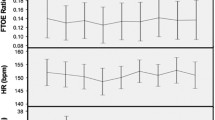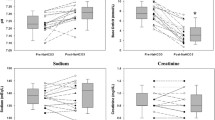Abstract
Objective
To analyze the cardiovascular effects of sodium bicarbonate in neonates with metabolic acidosis.
Design
Prospective, open, non-randomized, before-after intervention study with hemodynamic measurements performed before and 1, 5, 10, 20, and 30 min after bicarbonate administration.
Setting
Neonatal intensive care unit, tertiary care center.
Patients
Sequential sample of 16 paralysed and mechanically ventilated newborn infants with a metabolic acidosis (pH<7.25 in premature and <7.30 in term infants, base deficit>−8).
Intervention
An 8.4% sodium bicarbonate solution diluted 1∶1 with water (final osmolality of 1000 mOsm/l) was administered in two equal portions at a rate of 0.5 mmol/min. The dose in mmol was calculated using the formula “base deficit x body weight (kg)×1/3×1/2”.
Measurements and results
Sodium bicarbonate induced a significant but transient rise in pulsed Doppler cardiac output (CO) (+27.7%), aortic blood flow velocity (+15.3%), systolic blood pressure (BP) (+9.3%), (+14.6%), transcutaneous carbon dioxide pressure (PtcCO2) (+11.8%), and transcutaneous oxygen pressure (PtcO2) (+8%). In spite of the PaCO2 elevation, pH significantly improved (from a mean of 7.24 to 7.30), and the base deficit decreased (−39.3%). Calculated systemic vascular resistance (SVR) (−10.7%) and diastolic BP (−11.7%) decreased significantly, while PaO2 and heart rate (HR) did not change. Central venous pressure (CVP) (+6.5%) increased only slightly. By 30 min after bicarbonate administration all hemodynamic parameters, with the exception of the diastolic BP, had returned to baseline.
Conclusion
Sodium bicarbonate in neonates with metabolic acidosis induces an increase in contractility and a reduction in afterload.
Similar content being viewed by others
References
Iberti TJ, Kelly KM, Gentili DR, Rosen M, Katz DP, Premus G, Benjamin M (1988) Effects of sodium bicarbonate in canine hemorrhagic shock. Crit Care Med 16:779–782
Bersin RM, Chatterjee K, Arieff AI (1989) Metabolic and hemodynamic consequences of sodium bicarbonate administration in patients with heart disease. Am J Med 87:7–14
Mäkisalo HJ, Soini HO, Nordin AJ, Hoeckerstedt KAV (1989) Effects of bicarbonate therapy on tissue oxygenation during resuscitation of hemorrhagic shock. Crit Care Med 17:1170–1174
Huseby JS, Gumprecht DG (1985) Hemodynamic effects of rapid bolus hypertonic sodium bicarbonate. Chest 79:552–554
Graf H, Leach W, Arieff AI (1985) Evidence for detrimental effect of bicarbonate therapy in hypoxic lactic acidosis. Science 227:754–756
Cooper DJ, Wothley LIG (1987) Adverse haemodynamic effects of sodium bicarbonate in metabolic acidosis. Intensive Care Med 13:425–427
Bureau MA, Begin R, Berthiaume Y, Shapcott D, Khoury K, Gagnon N (1980) Cerebral hypoxia from bicarbonate infusion in diabetic acidosis. J Pediatr 96:968–973
Finberg L (1967) Dangers to infants caused by changes in osmolal concentration. Pediatrics 40:1031–1037
Rhodes PG, Hall RT, Hellerstein S (1977) The effects of single infusions of hypertonic sodium bicarbonate on body composition in neonates with acidosis. J Pediatr 90:789–795
Finberg J (1977) The relationship of intravenous infusions and intracranial hemorrhage—a commentary. J Pediatr 91:777–778
Papile LA, Burstein J, Burstein R, Koffler H, Koops B (1978) Relationship of intravenous sodium bicarbonate infusions and cerebral intraventricular hemorrhage. J Pediatr 93:834–836
Sessler D, Mills P, Gregory G, Litt L, James T (1987) Effects of bicarbonate on arterial and brain intracellular pH in neonatal rabbits recovering from hypoxic lactic acidosis. J Pediatr 111:817–823
Wheeler AS, Sadri S, Gutsche BB, Devore JS, David-Mian Z, Latisevsky H (1979) Intracranial hemorrhage following intravenous administration of sodium bicarbonate or saline solution in the newborn lamb asphyxiated in utero. Anaesthesiology 51:517–521
Savignoni PG, Bucci G, Ceccamea A, Mendicini M, Scalamandre A, Orzalesi MM (1969) Intravenous infusion of glucose and sodium bicarbonate in hyaline membrane disease. Acta Paediatr Scand 58:1–9
Kravath RE, Aharon AS, Abal G, Finberg L (1970) Clinically significant physiologic changes from rapidly administered hypertonic solutions: acute osmol poisoning. Pediatrics 46:267–275
Russel G, Cotton EK (1968) Effects of sodium bicarbonate by rapid injection and of oxygen in high concentration in respiratory distress syndrome of the newborn. Pediatrics 141:1063–1073
Alverson DC, Eldrigde M, Dillon T (1982) Noninvasive pulsed Doppler determination of cardiac output in neonates and children. J Pediatr 101:46–50
Sjöberg BJ, Wranne B (1990) Cardiac output determined by ultrasound-Doppler — clinical applications. Clin Physiol 10:463–473
Nicolosi GL, Pungercic E, Cervesato E (1988) Feasibility and variability of six methods for the echocardiographic and Doppler determination of cardiac output. Br Heart J 59:299–303
Notterman DA, Castello FV, Steinberg C (1989) A comparison of thermodilution and pulsed Doppler cardiac output measurement in critically ill children. J Pediatr 115:554–560
Hudson I, Houston A, Aitchison T (1990) Reproducibility of measurements of cardiac output in newborn infants by Doppler ultrasound. Arch Dis Child 65:15–19
Shapiro JI, Whalen M, Kucera R, Kindig N, Filley G, Chan L (1989) Brain pH responses to bicarbonate and cabicarb during systemic acidosis. Heart Circ Physiol 25:H1316-H1321
Simmons MA, Adcock EW, Bard H, Battaglia F (1974) Hypernatremia and intracranial hemorrhage in neonates. N Engl J Med 291:6–10
Perlman JM, Goodman S, Kreusser KL, Volpe JJ (1985) Reduction in intraventricular hemorrhage by elimination of fluctuating cerebral blood-flow velocity in preterm infants with respiratory distress syndrome. N Engl J Med 312:1353–1357
Lou HC, Lassen NA, Friis-Hansen B (1979) Impaired autoregulation of cerebral blood flow in the distressed newborn infant. J Pediatr 94:118–121
Weil HM, Rackow EC, Trevino R, Grundler W, Falk JL, Griffel MI (1986) Difference in acid-base state between venous and arterial blood during cardiopulmonary resuscitation. N Engl J Med 315:153–156
Adrogué HJ, Rashad MN, Gorin AB, Yacoub J, Madias NE (1989) Assessing acid-base status in circulatory failure: differences between arterial and central venous blood. N Engl J Med 320:1312–1316
Bishop RL, Weisfeldt ML (1976) Sodium bicarbonate administration during cardiac arrest. JAMA 235:506–509
Steichen JJ, Kleinman LI (1977) Studies in acid-base balance. I. Effect of alkali therapy in newborn dogs with mechanically fixed ventilation. J Pediatr 91:287–291
Tremper KK, Shoemaker WC (1981) Transcutaneous oxygen monitoring of critically ill adults, with and without low flow shock. Crit Care Med 10:706–709
Author information
Authors and Affiliations
Rights and permissions
About this article
Cite this article
Fanconi, S., Burger, R., Ghelfi, D. et al. Hemodynamic effects of sodium bicarbonate in critically ill neonates. Intensive Care Med 19, 65–69 (1993). https://doi.org/10.1007/BF01708362
Received:
Accepted:
Issue Date:
DOI: https://doi.org/10.1007/BF01708362




